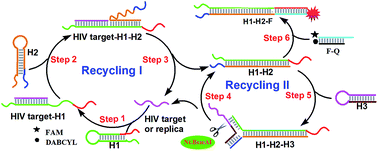A rapid room-temperature DNA amplification and detection strategy based on nicking endonuclease and catalyzed hairpin assembly†
Abstract
A novel and rapid room-temperature DNA amplification strategy to simultaneously amplify and detect target HIV DNA was developed by coupling catalyzed hairpin assembly (CHA) with a “non-sequence dependent” nicking endonuclease. In this system, a Nt.BsmAI nicking endonuclease recognition sequence and HIV target DNA sequence were integrated into hairpin probes H1 and H3, respectively. The HIV target DNA was repeatedly used to trigger a CHA reaction, forming numerous H1–H2 duplexes. Then the newly formed sticky ends of H1–H2 caused the hairpin structure of H3 to open. As a result, the double-stranded nicking enzyme recognition site was reunited, which was recognized and cleaved by the nicking enzyme. Finally, the target DNA replica with a sequence matching that of the HIV target DNA was obtained. The above reactions, namely, the CHA reaction, hairpin opening and enzyme cleavage, can be continuously repeated, leading to rapid room-temperature DNA amplification. In addition, this proposed rapid DNA amplification strategy enables picomolar detection of HIV DNA target within 10 min, providing a potential clinical application at point-of-care.



 Please wait while we load your content...
Please wait while we load your content...